新编实用英语综合教程教学大纲
新编实用英语综合教程第1册教学设计
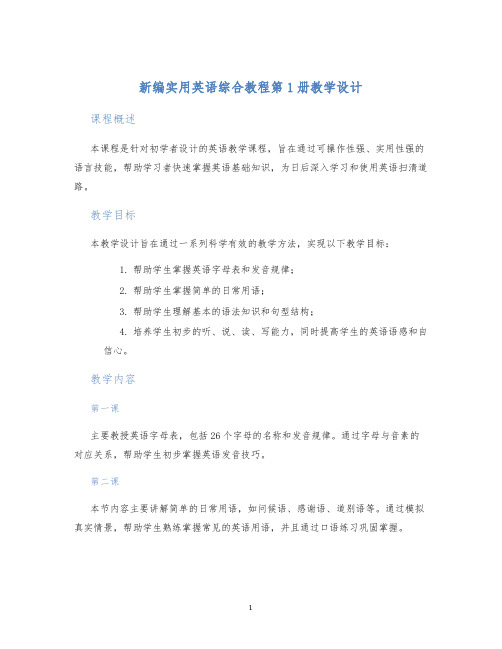
新编实用英语综合教程第1册教学设计课程概述本课程是针对初学者设计的英语教学课程,旨在通过可操作性强、实用性强的语言技能,帮助学习者快速掌握英语基础知识,为日后深入学习和使用英语扫清道路。
教学目标本教学设计旨在通过一系列科学有效的教学方法,实现以下教学目标:1.帮助学生掌握英语字母表和发音规律;2.帮助学生掌握简单的日常用语;3.帮助学生理解基本的语法知识和句型结构;4.培养学生初步的听、说、读、写能力,同时提高学生的英语语感和自信心。
教学内容第一课主要教授英语字母表,包括26个字母的名称和发音规律。
通过字母与音素的对应关系,帮助学生初步掌握英语发音技巧。
第二课本节内容主要讲解简单的日常用语,如问候语、感谢语、道别语等。
通过模拟真实情景,帮助学生熟练掌握常见的英语用语,并且通过口语练习巩固掌握。
第三课本节内容主要引导学生学习并掌握英语语法方面的基础知识,如主语、谓语、定语、状语等基本概念,并且通过练习巩固掌握。
第四课本节内容主要介绍英语代词、形容词、副词的基础知识,帮助学生掌握词汇量的同时,提高学生对英语语法的敏感性,同时辅以口语练习提高听说能力。
第五课本节内容主要让学生了解问题句型及回答方式,并帮助学生掌握各种相应句子类型的语法。
第六课综合性课程内容,巩固学生对前几节课的掌握,同时给予口语表达、语音、语法等方面的全面训练。
教学方法本教学设计将采用两大类方法,一类为传统教学方式,一类为现代教学方式。
传统教学方式1.讲授法:将基础知识讲授给学生,辅以学生手册和黑板板书,帮助学生初步掌握英语基础知识;2.练习法:通过不同形式的习题练习,巩固学生的掌握程度,并且帮助学生在做题过程中发现自己的不足,及时进行纠正。
现代教学方式1.互动式教学: 以学生为主体,让学生在讲师引导和促进下进行互动学习;2.多媒体教学: 利用现代多媒体教学手段,如PPT、录像等多媒体技术,结合学生实际情况和教学目标,对课程内容进行更直观、生动的展现。
新编实用英语综合教程第3册教学设计

新编实用英语综合教程第3册教学设计前言《新编实用英语综合教程》是当前国内比较优秀的综合英语教材之一,该教材分为三册,涵盖了英语语音、词汇、语法、听说读写等方面的内容。
本文将围绕第三册展开,提供一些教学设计的方案和思路,旨在帮助相关教师更好地教授该教材,并实现教学质量的提高。
教学目标本教学设计的教学目标如下:1.帮助学生巩固并丰富英语听说读写的基本能力。
2.培养学生运用英语口语和书面语进行沟通和交流的能力。
3.增强学生的综合语言应用能力和阅读理解能力。
4.发挥学生的主体性和创造性,积极参与英语教学活动。
教学内容与步骤第一部分:听力训练教师可以选择第三册中的听力材料,通过听力训练帮助学生提高自己的听力技能,并同时辅之以促进学生的口语交际能力。
具体的教学步骤如下:1.直接放给学生听的录音,让大家跟读练习,帮助学生提高自己的语音感知和表达能力。
2.给学生播放句子或者段落,学生进行理解和回答问题的训练。
3.注意训练中要积极鼓励学生参与,提高学生的运用英语进行口语交际的能力。
第二部分:阅读训练阅读是学习英语的一项非常重要的技能,阅读训练帮助学生巩固词汇和语法知识,培养学生的阅读能力。
具体的教学步骤如下:1.注重培养学生阅读的兴趣,引导学生阅读内容进入学习状态。
2.引导学生进行词汇和语法的理解、掌握和运用。
3.帮助学生提高阅读速度,增强阅读理解能力。
第三部分:口语交际训练口语交际训练是英语教学中不可或缺的一部分,这对于提高学生口语表达能力至关重要。
具体的教学步骤如下:1.教师可在语言教学中创设不同的场景,引导学生进行口语表达训练,比如询问日期、个人信息、健康情况等。
2.引导学生练习口语短语,提高学生口语表达的能力。
3.组织学生进行英语对话练习,帮助学生提高英文交流能力。
教学策略本教学设计中所采用的教学策略有:1.任务型教学策略:通过设置任务的方式让学生获得实践的机会,提高学生的语言运用和综合素养。
2.评价型教学策略:鼓励学生在听说读写的各个方面不断自我评价和检查,形成良好的学习习惯和反思意识。
新编实用英语综合教程1-3教案

Homework---P55.Put in Use
12’
75’
2’
作业布置
计划布置
实际布置
Ex.1-3,P55.
Ex.3,P55.
课后自评
教 案 内 容
教学提示
备课内容(教学设计、知识点、课堂组织、教学方法等)
SectionⅠ
Talking Face to Face
参看学学·练练·考考
教法选择
互动教学法(听与说的互动);角色表演法
Interactive Teaching Method; role-play
重点难点分析
1.Making/keeping/postponing/putting off an appointment according to a work timetables
Mr. Walker is a driver. He drives a bus to and from the airport. People using the airport take his bus. A schedule is important for him because his bus runs strictly on it. A schedule is also called a timetable.If Mr. Walker has only a few passengers, he still should leave on schedule. Only when he has a full load can he leave ahead of schedule. A full load means that every seat on the bus is taken. When a flight is late in arriving at the airport, he can wait until there are some passengers to take to the city.
新编实用英语教案
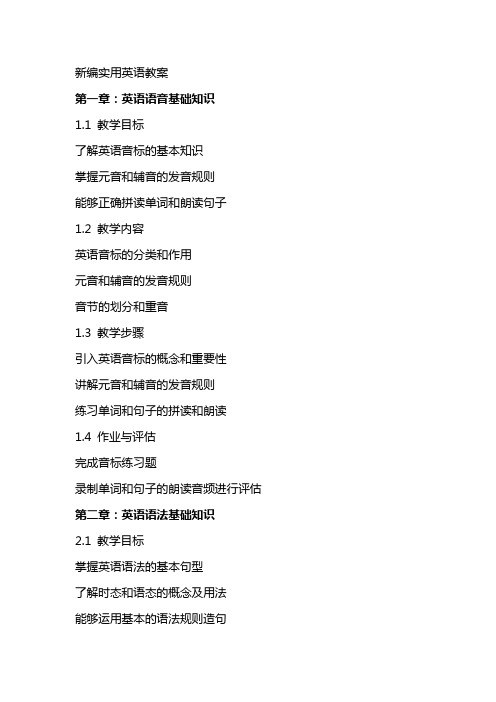
新编实用英语教案第一章:英语语音基础知识1.1 教学目标了解英语音标的基本知识掌握元音和辅音的发音规则能够正确拼读单词和朗读句子1.2 教学内容英语音标的分类和作用元音和辅音的发音规则音节的划分和重音1.3 教学步骤引入英语音标的概念和重要性讲解元音和辅音的发音规则练习单词和句子的拼读和朗读1.4 作业与评估完成音标练习题录制单词和句子的朗读音频进行评估第二章:英语语法基础知识2.1 教学目标掌握英语语法的基本句型了解时态和语态的概念及用法能够运用基本的语法规则造句2.2 教学内容英语基本句型:主语、谓语、宾语时态:一般现在时、一般过去时、一般将来时语态:主动语态、被动语态2.3 教学步骤讲解英语基本句型和语法结构介绍时态和语态的概念及用法练习运用基本语法规则造句2.4 作业与评估完成语法练习题编写短文或句子运用所学的语法知识进行评估第三章:英语词汇与短语3.1 教学目标扩充常用英语词汇和短语学会使用词汇和短语进行基本交流能够正确运用词汇和短语表达意思3.2 教学内容常用英语词汇和短语的分类和用法同义词和反义词的区分固定搭配和习惯用法3.3 教学步骤讲解词汇和短语的分类和用法练习运用词汇和短语进行交流学习同义词、反义词和固定搭配3.4 作业与评估完成词汇和短语练习题运用所学的词汇和短语进行口语交流或写作进行评估第四章:日常英语对话4.1 教学目标学会使用日常英语进行基本交流掌握常用的日常用语和表达方式能够运用日常英语进行问候、介绍、道别等场景的对话4.2 教学内容日常英语对话的常见场景和用语常用的日常表达方式和习惯用语情景对话的练习和角色扮演4.3 教学步骤讲解日常英语对话的常见场景和用语介绍常用的日常表达方式和习惯用语进行情景对话的练习和角色扮演4.4 作业与评估完成日常英语对话练习题进行角色扮演或实际交流进行评估第五章:英语阅读与写作5.1 教学目标提高英语阅读理解能力能够理解和运用所学的词汇和语法知识5.2 教学内容英语阅读材料的选取和分析阅读理解的技巧和策略英语文章的基本结构和写作技巧5.3 教学步骤讲解阅读材料的选取和分析方法介绍阅读理解的技巧和策略5.4 作业与评估评估阅读理解的能力和文章的质量第六章:英语听力技巧6.1 教学目标提高学生的英语听力理解能力学会使用听力技巧和策略能够理解和运用所学的词汇和语法知识6.2 教学内容听力材料的选取和分析听力理解的技巧和策略听力练习和反馈6.3 教学步骤讲解听力材料的选取和分析方法介绍听力理解的技巧和策略进行听力练习和反馈6.4 作业与评估完成听力练习题评估听力理解的能力和质量第七章:英语口语表达技巧7.1 教学目标提高学生的英语口语表达能力学会使用口语表达技巧和策略能够运用日常英语进行问候、介绍、道别等场景的对话7.2 教学内容口语表达材料的选取和分析口语理解的技巧和策略口语练习和角色扮演7.3 教学步骤讲解口语表达材料的选取和分析方法介绍口语理解的技巧和策略进行口语练习和角色扮演7.4 作业与评估完成口语练习题进行角色扮演或实际交流进行评估第八章:英语电子邮件和商务通信8.1 教学目标掌握电子邮件和商务通信的基本格式和礼仪能够运用所学的词汇和语法知识进行有效的商务沟通8.2 教学内容英语电子邮件和商务通信的基本格式和要素电子邮件和商务通信的礼仪和技巧实际案例分析和角色扮演8.3 教学步骤讲解英语电子邮件和商务通信的基本格式和要素介绍电子邮件和商务通信的礼仪和技巧进行实际案例分析和角色扮演8.4 作业与评估完成英语电子邮件和商务通信练习题评估电子邮件和商务通信的质量和建议第九章:英语面试技巧9.1 教学目标提高学生的英语面试技巧和表达能力学会使用面试技巧和策略能够运用所学的词汇和语法知识进行面试9.2 教学内容面试材料的选取和分析面试理解的技巧和策略面试练习和反馈9.3 教学步骤讲解面试材料的选取和分析方法介绍面试理解的技巧和策略进行面试练习和反馈9.4 作业与评估完成面试练习题进行模拟面试和评估第十章:英语考试技巧10.1 教学目标提高学生的英语考试技巧和应对能力学会使用考试技巧和策略能够运用所学的词汇和语法知识应对各种英语考试10.2 教学内容英语考试材料的选取和分析考试理解的技巧和策略考试练习和反馈10.3 教学步骤讲解英语考试材料的选取和分析方法介绍考试理解的技巧和策略进行考试练习和反馈10.4 作业与评估完成考试练习题进行模拟考试和评估第十一章:英语文化常识11.1 教学目标了解英语国家的文化背景和习俗学会使用英语进行文化交流和表达能够理解和尊重不同文化差异11.2 教学内容英语国家的基本文化知识,如节日、饮食、礼仪等文化差异的识别和表达跨文化交流的技巧和策略11.3 教学步骤讲解英语国家的文化背景和习俗介绍文化差异的表达和识别方法进行跨文化交流的练习和角色扮演11.4 作业与评估完成文化常识练习题进行跨文化交流的实际应用和评估第十二章:英语歌曲与听力12.1 教学目标利用英语歌曲提高听力理解能力学会欣赏和分析英语歌曲的韵律和词汇能够跟随歌曲节奏进行朗读和演唱12.2 教学内容英语歌曲的选择和分析歌曲中的韵律和词汇特点歌曲听力练习和演唱12.3 教学步骤讲解英语歌曲的选择和分析方法介绍歌曲中的韵律和词汇特点进行歌曲听力练习和演唱12.4 作业与评估完成歌曲听力练习题评估歌曲理解和演唱能力第十三章:英语电影与口语13.1 教学目标利用英语电影提高口语表达能力学会分析和模仿电影中的口语表达能够运用电影中的口语进行实际交流13.2 教学内容英语电影的选取和分析电影中的口语表达和特点口语模仿和角色扮演13.3 教学步骤讲解英语电影的选取和分析方法介绍电影中的口语表达和特点进行口语模仿和角色扮演13.4 作业与评估完成口语模仿练习题进行角色扮演或实际交流进行评估第十四章:英语新闻与阅读14.1 教学目标提高英语新闻阅读理解能力学会分析和理解新闻报道的结构与内容能够运用所学的词汇和语法知识进行新闻阅读14.2 教学内容英语新闻材料的选取和分析新闻报道的结构和特点阅读理解的技巧和策略14.3 教学步骤讲解英语新闻材料的选取和分析方法介绍新闻报道的结构和特点进行新闻阅读理解和讨论14.4 作业与评估完成新闻阅读练习题评估新闻阅读理解的能力和质量第十五章:英语演讲与写作15.1 教学目标提高学生的英语演讲和写作能力学会使用演讲技巧和写作策略能够运用所学的词汇和语法知识进行有效的演讲和写作15.2 教学内容英语演讲的材料选取和分析演讲技巧和表达方式英语写作的基本结构和技巧15.3 教学步骤讲解英语演讲的材料选取和分析方法介绍演讲技巧和表达方式进行演讲练习和反馈15.4 作业与评估完成英语演讲和写作练习题进行演讲和写作评估和反馈重点和难点解析本文主要介绍了新编实用英语教案,共包含十五个章节。
新编实用英语综合教程1教案

与手段
Teachingand role play
教学过程(教学环节、各环节要点、时间分配等)
第
一
节
1.Reviewthe useful expressions about how to greet people and giveresponses;
2.The way Americans greet;
3.Practice the dialogues
10min
20min
10min
第
二
节
Being All Ears
Review
35min
5min
教学
小结
Students have learned how to greet people and give responses, and exchange personal informations
eful words and expressions.
5min
20min
15min
第
二
节
1.Reading of the passage;
2.Do and explain the exercises.
3.Review
10min
25min
5 min
教学
小结
Students have learned the way howAmerican and British people greet each other.
3.Introducing people to each other;
4.Key words and expressions.
教学方法
与手段
Teaching androle play
新编实用英语综合教程1-5教案
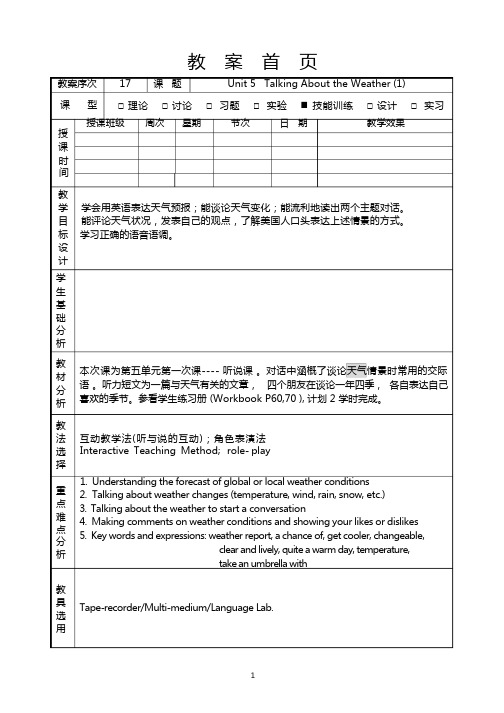
教 案 首 页教案序次 17 课 题 Unit 5 Talking About the Weather (1) 课 型 □ 理论 □ 讨论 □ 习题 □ 实验 ■ 技能训练 □ 设计 □ 实习 授课班级 周次 星期 节次 日 期 教学效果授课时间 教学 学会用英语表达天气预报;能谈论天气变化;能流利地读出两个主题对话。
目 能评论天气状况,发表自己的观点,了解美国人口头表达上述情景的方式。
标 学习正确的语音语调。
设计本次课为第五单元第一次课---- 听说课 。
对话中涵概了谈论天气情景时常用的交际 语 。
听力短文为一篇与天气有关的文章, 四个朋友在谈论一年四季, 各自表达自己 喜欢的季节。
参看学生练习册 (Workbook P60,70 ), 计划 2 学时完成。
互动教学法(听与说的互动);角色表演法 Interactive Teaching Method; role-play 1. Understanding the forecast of global or local weather conditions 2. Talking about weather changes (temperature, wind, rain, snow, etc.) 3. Talking about the weather to start a conversation 4. Making comments on weather conditions and showing your likes or dislikes 5. Key words and expressions: weather report, a chance of, get cooler, changeable, clear and lively, quite a warm day, temperature, take an umbrella with Tape-recorder/Multi-medium/Language Lab.学 生 基 础 分 析 教材分析教法选择重点难点分析教具选用课 堂 组 织 Unit FiveSection Ⅰ& Section Ⅱ Language Points: 1. Centigrade / Celsius / Fahrenheit 2. forecast n./v. predict —prediction —predictable —predictably 3. improve —improvement 4. weather / climate 5. variable —various —vary —variety 6. suffer from 7. show--shower序号 ◆ Pre-teaching 知识点 时间 12’ Review ---- Unit 4 Lead-in ---- weather forecast ◆ While-teaching Follow the Samples ---- Talking About the Weather Today Talking About the Weather in New York Being all ears ---- Dialogue & Passage ◆ Post-teaching 75’ 2’ Summary Homework---P72. Put in Use 计划布置 Ex.1-3, P72. 实际布置 Ex.3, P72. 课 后 自评作 业 布 置 知识点及时间分配主板书设计教案内容备课内容(教学设计、知识点、课堂组织、教学方法等)Unit Five: Talking About the Weather (1)(Note:★ ---focal point,▲ --- difficult point)Ⅰ . IntroductionThe topic area of Talking Face to Face in this unit is to talk about the weather. The focus is on the patterns that are appropriate for getting or giving information about weather conditions for the daily activities or arrangements.Ⅱ . Lead-in: business cards1. Warm-up questions◇Do you often listen to a weather forecast? Why or why not?◇What’s the use and importance of a weather forecast?2. Students read and translate the business cards under the guidance of the teacher.Ⅲ . Sample Dialogues1. Warm-up questions◇Do you often talk ab out the weather and the weather forecast? ◇Do you know how to describe the weather in English?2. Students read the sample dialogues after the teacher and try to find out the useful sentences and expressions for talking about the weather in the dialogues.3. Students practice the dialogues in groups.4. Give students several minutes to prepare short conversations in pairs by simulating the five small dialogues.5. Students role-play the similar situations they create consulting the five small dialogues, first in groups, and then in front of the class.Ⅳ . Assignments for this section:﹡ Pair work: Talk about/Describe the weather conditions in your hometown to other members of the group.﹡ Students do Put-in-Use exercises in groups in groups by reading out loud all the three dialogues they have completed.Section ⅡBeing All Ears Ⅴ . Listening Practice1. Give the students a few minutes to read through the printed materials for each listening item.2. Listen to the tape for the first time without looking at the book. 3. Play the tape with a pause after each sentence for the second time and ask the students to take notes of the key words.教学提示Section ⅠTalking Face toFace参看学学·练练·考考(WorkbookP60,P70)4. Play the tape for the third time, and ask the students to simultaneously repeat while they are listening.5. Do all the exercises in this section.Ⅵ .ScriptDialogue(Pat Alex comes by to see Li Hong. They talk about the party last night and about theweather.)Li Hong: Hi, Pat! Why didn't you go to the party last night?Pat: Because it was so cold and rainy.Li Hong: That's too bad! It was a really good party. Hey, why don't wego for a walk this afternoon, Pat? I need some exercise.Pat: Go for a walk? But it's so cold out.Li Hong:Cold out? What's the temperature?Pat:About 13 °C.Li Hong:13 °C That's not cold. Just wait until winter.Pat:Why?Li Hong: Well ... it snows a lot and sometimes it's very cold. Last winterit was 7 degrees below zero for three weeks. And it was windy, too.Pat:That sounds awful!Li Hong: It wasn't all that bad. The sun was out almost every day.The GeneralIdea of thePassagekey play in the fresh air, aummer vacation, hot and unconfortable, in summertime, go skating on the ice, begin to grow, a new year begins, arechanging color, fall from the trees, in the air教 案 首 页教案序次 18 课 题 Unit 5 Talking About the WEather(2) 课 型 ■ 理论 □ 讨论 □ 习题 □ 实验 □ 技能训练 □ 设计 □ 实习授课班级 周次 星期 节次 日 期 教学效果·牢记 Passage 1 中所出现的生词和短语, 理解课文大意, 学会用英语表述天气状况。
新编实用英语综合教程1第五版第二单元课件

新编实用英语综合教程1第五版第二单元课件第一部分:介绍课程概述本单元课件旨在帮助学生提高英语综合应用能力,重点讲解实用英语的基本知识和技巧。
通过本单元的学习,学生将能够掌握基本的英语交流技巧,并能够在日常生活和工作中有效地运用所学的英语知识。
第二部分:听力训练本部分内容围绕着有效的听力训练展开,学生将通过多种听力材料来训练自己的听力技巧和理解能力。
同时,课件还提供了一些听力练习题目,帮助学生巩固所学的听力知识。
第三部分:口语表达本部分将帮助学生提高口语表达能力,包括日常对话、电话沟通和面试技巧等内容。
通过模拟对话和实际情景练习,学生将能够更加自信地进行英语口语交流。
第四部分:阅读理解本部分将为学生提供最新的英语阅读材料,涵盖社会、文化、科技等多个领域。
通过阅读这些材料,学生将培养自己的阅读理解能力,并了解到当代世界的发展动态。
第五部分:写作技巧本部分着重讲解英语写作的技巧和要点,包括句子结构、段落组织、篇章连贯等方面。
学生将通过实际的写作练习来提高自己的英语写作水平。
第六部分:语法讲解本部分将详细介绍英语语法的重要内容,帮助学生理解语法规则并正确运用。
通过各种练习题,学生将能够熟练掌握英语语法知识,提高语言表达的准确性。
第七部分:词汇扩充本部分将为学生提供丰富的词汇学习资源,并涵盖各个语境和主题。
通过词汇的学习和记忆,学生将拓展自己的词汇量,提高英语的表达能力。
第八部分:综合测试本部分将对学生进行一次综合性的测试,用以检验他们在本单元中的掌握程度。
学生将通过测试来评估自己的学习成果,并查漏补缺,进一步提高自己的英语综合能力。
结语:通过本单元课件的学习,相信学生们能够在英语学习的道路上更加自信和有效地前行。
希望学生们能够将所学的知识运用到实际生活中,并不断提升自己的英语水平。
祝愿大家学有所成,取得优异的成绩!。
新编实用英语教学大纲

《实用英语》课程教学大纲课程编号:51101适用专业:高职高专非英语专业一、二年级学生总学时数:164学时;其中:理论教学164学时先修课程:中学英语考核方式:考试一、制订大纲的依据本大纲根据《高职高专教育英语课程教学基本要求》(试行)制订。
二、课程简介《实用英语》课程即《公共英语》课,是高职高专非英语专业学生的公共必修课;教学对象为高职高专非英语专业一、二年级学生。
本课程的教学目的在于:经过约180学时的教学,使学生掌握一定的英语基础知识和技能,具有一定的听、说、读、写、译的能力,从而能借助词典阅读和翻译有关英语业务资料,在涉外交际的日常活动和业务活动中进行简单的口头和书面交流,并为今后进一步提高英语的交际能力打下基础。
三、本课程性质、教育目标(一)性质:本课程面向高职、高专非英语专业一、二年级学生开设,为公共基础课。
(二)教育目标:本课程是非英语专业的公共基础课程,本课程的任务是经过三个学期约180学时的教学,使学生掌握英语日常会话、科技英语阅读、科技英语翻译及英语应用文写作的基本方法和技能,掌握大约2,500个常用英语单词和词组,能够借助词典阅读和翻译与专业相关的简单英语资料,并具有一定的涉外交际能力,以满足学生在今后工作中的需要。
四、课程教学内容与基本要求课程基本要求:鉴于目前高职、高专和成人高专学生入学时的英语水平差异较大,本课程的教学要求分为A、B两级,实行分级指导。
A级是标准要求,B级是过度要求。
入学水平较高的学生应达到A级要求,入学水平较低的学生至少应达到B级要求。
随着入学英语水平的不断提高,学生均应达到A级要求。
本课程在加强英语语言基础知识和基本技能训练的同时,重视培养学生实际使用英语进行交际的能力。
通过本课程的学习,学生应该达到下列要求:1.词汇A 级:认知3 400个英语单词(包括入学时要求掌握的1600个词)以及由这些词构成的常用词组,对其中2000个左右的单词能正确拼写,英汉互译。
新编实用英语综合教程2unit-1-教案

新编实用英语综合教程2unit-1-教案Unit OneInvitation EtiquetteTeaching ObjectiveIn "Talking Face to Face", learn how to invite friends to attend a party or a dance in oral English.In "Being All Ears", students will fine tune their listening and comprehension skills through exercises relating to inviting people out.In "Maintaining a Sharp Eye",students will learn how foreign people deal with invitations, when one wants to accept or does not accept.In "Trying Your Hand", get some practical experience and writing a invitation and a reply to the invitation one gets.Teaching ProceduresSection I Talking Face to Face1.Warm- up:Patterns and expressions for talking about invitations:I’d like to invi te you to dinner.我想请你吃晚饭。
Why don’t you come and join us for disco?你为什么不和我们一起跳迪斯科?It’s very kind of you to invite me.谢谢你邀请我。
新编实用英语综合教程2 -Unit 5 Food culture教案

Unit 5 Food Culture Unit GoalsWhat you should learn to do1.Choose a table2.Order from a menu3.Take an order4.Enquire about and recommend foods and drinks5.Pay the billWhat you should know about1.Western and Chinese food2.The way to make a toast speech at a wedding3.Adverbial clausesSection I Talking Face to Face1.Imitating Mini-Talks2.Acting out the Tasks3.Studying Email Information on the Internet4.Following Sample Dialogues5.Putting Language to UseSection II Being All Ears1.Learning Sentences for Workplace Communication2.Handling a Dialogue3.Understanding a Short Speech / TalkSection III Trying your Hand1.Practicing Applied Writing2.Writing Sentences and Reviewing GrammarSection IV Maintaining a Sharp EyePassage 1 :Information Related to the Reading PassageLikes or dislikes with regard to food vary greatly from culture to culture. What is disgusting to one person can be a delicacy to another. Sometimes we need to change our eating habits. If we move or travel to a new place with a different culture, our favorite meat, fruit and vegetables may not be available to us. As a result, we have to eat what is different from the food we are used to. Slowly, this strange food may become familiar to us. Our tastes may change, too, and we begin to enjoy eating the food that used to seem unusual to us.Text Blogs on FoodBlog One2014/5/14Best Places to Eat in Beijing and ShanghaiThis will be our first time in Beijing and Shanghai. One of the best things about traveling is all the different foods you get to try. There is Chinese food in the US, but it’s not nearly as good as the food in China! Plus there are lots of things you can’t get in the US.Now we are wondering about what people who actually live in Shanghai and Beijing think are the best places to eat?If you can leave a message below that would be great. Amy2014/5/15You’ve got to have Beijing Duck at Quan Ju De ( 全聚德). You’re not a vegetarian right? LOL. Have a nice time in Beijing.2014/5/18Must go places for eating: I guess the only thing I would recommend is the Xiaolong Bao in Yu Garden ... uh ... it’s a little bit cliché... but it is still the signature dish of Shanghai ... apart from that, you can find every kind of dishes of regional flavor there ... god bless.Ming Tao2014/5/20Its a pity u stay in Hangzhou only a few hours, flying guys! Xuehe20014/5/28Hi! It was really nice meeting you today at the bar! Hope you enjoyed your stay here in Shanghai so far ... and you can try Shanghainese cuisine some time ... or maybe some snacks at the City God’s Temple (Chenghuang Miao in Chinese). They’re really one of a kind.Blog Twoby Chang Weng, from MalaysiaFunny, Isn’t It?Tuesday morning, I over-slept, while all the bosses were coming.Fortunately I was not coming late, just having no time to da bao my lunch.Me: Qiu Jun, I did not “da bao”today. If you go out for lunch,remember to bring me together.Qiu Jun: Ok, A Weng. I’ll go out for lunch later on.(Few minutes just before the lunch hour.)Qiu Jun: A Weng, let’s go for lunch now.Uncle Zhou: Today we bring A Weng to the sea.Me: Sea? (Sure? Qiu Jun and me don’t know how to swim!)Qiu Jun: Good idea.Me: Oh ... (These 2 bosses must have something secret in their plan.)Few minutes after sitting inside Qiu Jun’s car, huh, we are really reaching the sea.Oh, actually they target on the Sunrise Seafood Restaurant, which is just located besides our company, but we need to turn a big round only to reach there.Hmm, this restaurant is quite good, “floating”on top of the sea. An unlimited sea-view.Uncle Zhou treats us to lunch there. Wow, we finish almost all the ordered food. I feel surprised that I do not recommend food over here. Hehe, I cannot tell my mother, or else she will call me immediately with blar blar blar.Mum, don’t worry, I did not eat any meat, see, my plate is empty. Language Points1 Explanation of Difficult Sentences1. (Blog 1 –Amy) Now we are wondering about what people who actually live in Shanghai and Beijing think are the best places to eat?Analysis: This is a complex sentence. In this sentence what people who actually live in Shanghai and Beijing think are the best places to eat is an object clause of the preposition about, and who are ctually live in Shanghai and Beijing is used as an attributive clause modifying people.Translation: 现在我们想知道,真正住在上海和北京的居民认为什么地方的东西最好吃。
新编实用英语综合教程2 -Unit 7 Bidding Farewall教案

Unit 7 Bidding FarewellUnit GoalsWhat you should learn to do1.See off a friend and wish him/her a pleasent journey2.Make a farewell speech to:Express thanks for the host’s hospitalityAppreciate the pleasant cooperationExpress good wishes for the future3.Write a farewell letterWhat you should know about1.Two ways to prepare an English farewell speech and write a farewell letter2.Emphasis, ellipsis and inversion in a sentenceSection I Talking Face to Face1.Imitating Mini-Talks2.Acting out the Tasks3.Studying Email Information on the Internet4.Following Sample Dialogues5.Putting Language to UseSection II Being All Ears1.Learning Sentences for Workplace Communication2.Handling a Dialogue3.Understanding a Short Speech / TalkSection III Trying your Hand1.Practicing Applied Writing2.Writing Sentences and Reviewing GrammarSection IV Maintaining a Sharp EyePassage 1 :Text The Most Unforgettable Character I’ve MetI remember vividly that first English class in the last term of high school. We boys (there were no girls in the school) were waiting expectantly for the new teacher to appear。
新编实用英语综合教程1-5教案

新编实用英语综合教程1-5教案教案首页教案序次17 课题Unit 5 Talking About the Weather(1)课型□理论□讨论□习题□实验■技能训练□设计□实习授课时间授课班级周次星期节次日期教学效果教学目标设计学会用英语表达天气预报;能谈论天气变化;能流利地读出两个主题对话。
能评论天气状况,发表自己的观点,了解美国人口头表达上述情景的方式。
学习正确的语音语调。
学生基础分析教材分析本次课为第五单元第一次课----听说课。
对话中涵概了谈论天气情景时常用的交际语。
听力短文为一篇与天气有关的文章,四个朋友在谈论一年四季,各自表达自己喜欢的季节。
参看学生练习册(Workbook P60,70 ),计划2学时完成。
教法选择互动教学法(听与说的互动);角色表演法Interactive Teaching Method; role-play重点难点分析1.Understanding the forecast of global or local weather conditions2.Talking about weather changes (temperature, wind, rain, snow, etc.)3.Talking about the weather to start a conversation4.Making comments on weather conditions and showing your likes or dislikes5.Key words and expressions: weather report, a chance of, get cooler, changeable,clear and lively, quite a warm day, temperature,take an umbrella with教具选用Tape-recorder/Multi-medium/Language Lab.课堂组织主板书设计Unit FiveSectionⅠ& Section ⅡLanguage Points:1.Centigrade / Celsius / Fahrenheit2.forecast n./v. predict—prediction—predictable—predictably3.improve—improvement4.weather / climate5.variable—various—vary—variety6.suffer from7.show--shower知识点及时间分配序号知识点时间◆Pre-teachingReview ---- Unit 4Lead-in ---- weather forecast◆While-teachingFollow the Samples ---- Talking About the Weather TodayTalking About the Weather in New YorkBeing all ears ---- Dialogue & Passage◆Post-teachingSummaryHomework---P72. Put in Use12’75’2’作业布置计划布置实际布置Ex.1-3,P72.Ex.3,P72.课后自评教案内容教学提示备课内容(教学设计、知识点、课堂组织、教学方法等)Section ⅠTalking Face toFace参看学学·练练·考考(Workbook P60,P70)Section ⅡBeing All EarsUnit Five: Talking About the Weather(1)(Note:★---focal point,▲--- difficult point)Ⅰ.IntroductionThe topic area of Talking Face to Face in this unit is to talk about the weather. The focus is on the patterns that are appropriate for getting or giving information about weather conditions for the daily activities or arrangements.Ⅱ.Lead-in: business cards1.Warm-up questions◇Do you often listen to a weather forecast? Why or why not?◇What’s the use and importance of a weather forecast?2. Students read and translate the business cards under the guidance of the teacher.Ⅲ. Sample Dialogues1. Warm-up questions◇Do you often talk about the weather and the weather forecast?◇Do you know how to describe the weather in English?2. Students read the sample dialogues after the teacher and try to find out the useful sentences and expressions for talking about the weather in the dialogues.3. Students practice the dialogues in groups.4. Give students several minutes to prepare short conversations in pairs by simulating the five small dialogues.5. Students role-play the similar situations they create consulting the five small dialogues, first in groups, and then in front of the class.Ⅳ. Assignments for this section:﹡Pair work: Talk about/Describe the weather conditions in your hometown to other members of the group.﹡Students do Put-in-Use exercises in groups in groups by reading out loud all the three dialogues they have completed.Ⅴ. Listening Practice1.Give the students a few minutes to read through the printed materials for each listening item.2.Listen to the tape for the first time without looking at the book. 3.Play the tape with a pause after each sentence for the second time and ask the students to take notes of the key words.Dialogue The General Idea of the Passagekey 4.Play the tape for the third time, and ask the students to simultaneously repeat while they are listening.5.Do all the exercises in this section.Ⅵ.Script(Pat Alex comes by to see Li Hong. They talk about the party last night and about the weather.)Li Hong: Hi, Pat! Why didn't you go to the party last night?Pat: Because it was so cold and rainy.Li Hong: That's too bad! It was a really good party. Hey, why don't wego for a walk this afternoon, Pat? I need some exercise.Pat: Go for a walk? But it's so cold out.Li Hong: Cold out? What's the temperature?Pat: About 13 °C.Li Hong: 13 °C That's not cold. Just wait until winter.Pat: Why?Li Hong: Well ... it snows a lot and sometimes it's very cold. Last winterit was 7 degrees below zerofor three weeks. And it waswindy, too.Pat: That sounds awful!Li Hong: It wasn't all that bad. The sun was out almost every day.play in the fresh air, aummer vacation, hot and unconfortable, in summertime, go skating on the ice, begin to grow, a new year begins, are changing color, fall from the trees, in the air教案首页教案序次18 课题Unit 5 Talking About the WEather(2)课型■理论□讨论□习题□实验□技能训练□设计□实习授课时间授课班级周次星期节次日期教学效果教学目标设计·牢记Passage 1 中所出现的生词和短语,理解课文大意,学会用英语表述天气状况。
新编实用英语综合教程--教案
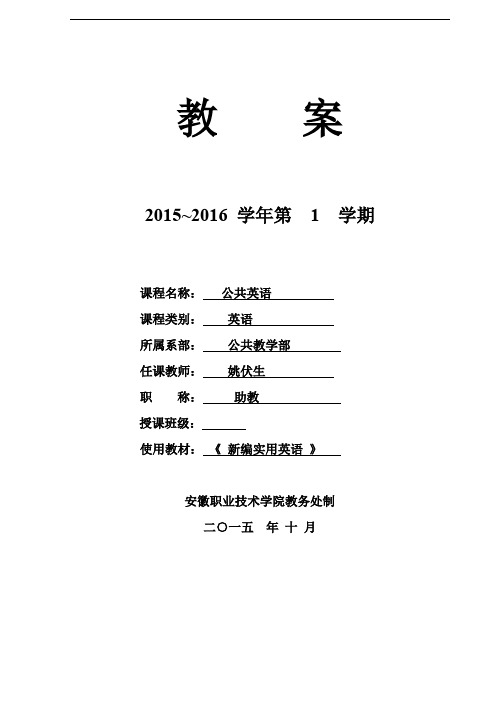
教案2015~2016 学年第 1 学期课程名称:公共英语课程类别:英语所属系部:公共教学部任课教师:姚伏生职称:助教授课班级:使用教材:《新编实用英语》安徽职业技术学院教务处制二○一五年十月教案头教案头Unit 1 Hello, Hi!SectionⅠTalking Face to FaceI.Imitating Mini-talks1. pair worka. The students are asked to read the first three talks in pairs and speak out the sentences used when people meet for the first time.b. The students are then asked to read the last two talks in pairs and speak out the sentences used when people meet again.2. The teacher may give more expressions for the students to practice.II. Acting out tasksPair work. The students make short conversations by following the above mini-talks.III. Studying Business Cards1.The students read the business cards and answer some questions.Questions for the two cardsa.What’s the nam e of the man?b.Where does he work?c.What is his job?d.Where is his working place?2.The students read the letter again and then translate it orally under the guidance of the teacher.IV Following sample dialoguesThe students read the dialogues and speak out the following sentences of greeting and introducing people. Then the students will be asked to practice them.1.Hello, nice to meet you . My name is .......2. How do you do, ... I’m ....3. Welcome to ...4. Here is my card.5. Hi, long time no see6. How nice to see you again7. Haven’t seen you for ages8. What a pleasant surprise!V Putting language to useThe students do the exercises 5 and 6 according to the knowledge they have mastered in the dialogues.教案头Unit 1 Hello, Hi!Section ⅡBeing All EarsI Learning sentences for workplace communicationThis part is to train the students to understand and speak out the sentences.4.The students listen to ten English sentences given in the course book and repeat them in the pauseallowed, trying to understand and learn to speak them out by referring to their Chinese meanings.5.The students listen to ten sentences , and match them with their Chinese translations.6.The students listen to six sentences giving in the course book, and then choose their right responses.2.II Handing a dialogue s.This part is moving from the sentence to the dialogue level.The students listen twice to a dialogue, and then decode the message given in the course book by finding the correct choiceIII. Understanding a short speechThis part of training is carried out to help the students to follow the continuous oral presentation of a specific practical activity which is oriented to the unit topic.1. The students listen to the speech twice and during the second listening, put back the missing words in the blanks.2. The students listen to the speech again and match the information in Column A with the choices in Column B.教案头Unit 1 Hello, Hi!Section III Trying Your HandI Practicing applied writing1. Sample analysisThe teacher makes the following brief analysis of the format and language used in business cards. The teacher may take Sample 1 as an example for the analysis and asks the students some questions:a.What’s the name of the man?b.Where does he work?c.What is his job?d.Where is his working place?2.personal information must be included in a business cardfull name job working place unit address telephone number E-mail FaxII Writing sentences and reviewing grammarThe teacher introduce basic sentence structures with the following examples.1. 主语+谓语(+宾语)(+状语)Animals can’t speak (主+谓)Mary runs every morning (主+谓+状)They speak English (主+谓+宾)I gave him a visiting card.(主+谓+间宾+直宾)She loves dogs very much. (主+谓+宾+状)2.主系表He is a man3.There be 句型There is a dog in the room教案头Unit 1 Hello, Hi!Section ⅣPassage I The Business Cards:I. Warming-up questionsi. What do you think of a business card?ii. What tips should you know about the business card?II. Ask the students to skim the passage and answer the questions on Page 16.1. Have you got your business cards or networking cards? If not, why not?2. How do you understand the title of the passage The Business Card: a Social Faux Pas?A business card is a useful tool of social networking and business connection. It is socially awkward if you find yourself without one when you need to exchange it with a new business partner.3.Why does the author say “missed connections are missed opportunities for business”? Because business cards are a useful marketing tool. If you forget to bring them with you, it May leave the impression that you are unprepared for doing business.4. Can you explain the tips in your own words?1) If you don't have a job, prepare your cards for networking.2) If your business cards are out of date, make them up to date.3) You should set a goal of handing out a certain number of cards every day.4) Practice what you will say for handing out your cards. Take every opportunity to handout your cards.5) Ask your social network to help you send out your cards.5. What does the last sentence mean?You should work in a clever way: better work isn't necessarily harder!III. Ask students to read the new words and expressions and check their pronunciation.IV. Play the tape for the students and ask them to imitate.V. Analyze the passage and explain the language and difficult sentences.Para11. ask for sth: want sthMay I ask for a photo of your little daughter? 我能要一张你小女儿的照片吗?ask for sbHe is very ill and keeps asking for his daughter. 他病得很厉害, 再三要求见他的女儿。
《新编实用英语综合教程》第1册 第1单元教案
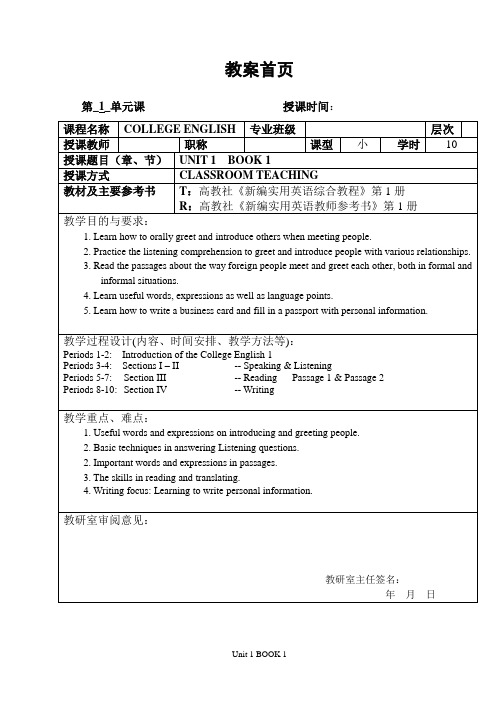
2. Important words and expressions in passages.
3. The skills in reading and translating.
4. Writing focus: Learning to write personal i年月日
教案首页
第_1_单元课授课时间:
课程名称
COLLEGE ENGLISH
专业班级
层次
授课教师
职称
课型
小
学时
10
授课题目(章、节)
UNIT 1 BOOK 1
授课方式
CLASSROOM TEACHING
教材及主要参考书
T:高教社《新编实用英语综合教程》第1册
R:高教社《新编实用英语教师参考书》第1册
教学目的与要求:
1. Learn how to orally greet and introduce others when meeting people.
2. Practice the listening comprehension to greet and introduce people with various relationships.
3. Read the passages about the way foreign people meet and greet each other, both in formal and informal situations.
4. Learn useful words, expressions as well as language points.
- 1、下载文档前请自行甄别文档内容的完整性,平台不提供额外的编辑、内容补充、找答案等附加服务。
- 2、"仅部分预览"的文档,不可在线预览部分如存在完整性等问题,可反馈申请退款(可完整预览的文档不适用该条件!)。
- 3、如文档侵犯您的权益,请联系客服反馈,我们会尽快为您处理(人工客服工作时间:9:00-18:30)。
新编实用英语综合教程教学大纲 教学大纲是根据《高职高专教育英语课程教学基本要求(试行)》,并结合我校实际情况编写。 学时: 第一学期 64 学时,第二学期72学时,每周授课4学时,开设两个学期,共计 136 学时。 适应专业: 高职高专各个专业。(商务英语专业除外) 一、课程的性质和任务 课程性质: 本课程为公共必修课。 课程任务 :经过两个学期的学习,完成《新编实用英语综合教程》一至二册的教学,使学生掌握一定的英语基础知识和技能,具有一定的听、说、读、写、译的能力,从而能借助词典翻译和阅读有关英语业务资料,在涉外交际的日常活动和业务活动中进行简单的口头和书面交流,并为今后进一步提高英语的交际能力打下基础。 相关课程: 根据各专业自行设计安排,部分专业在修完本课程后开设专业英语。(计算机英语、秘书英语、汽车英语等) 二、课程的基本要求 本课程在加强英语语言基础知识和基本技能训练的同时,重视培养学生实际使用英语进行交际的能力。通过学习本课程,学生应该达到以下要求: 1、词汇 认知 2500 个英语单词(包括入学时要求掌握的 1000 个词)以及由这些词构成的常用词组,对其中 1500 个左右的单词能正确拼写,能进行英汉互译。 2、语法 掌握基本的英语语法规则,在听、说、读、写、译中能正确运用所学的语法知识。 3、听力 能听懂涉及日常交际的结构简单、发音清楚、语速较慢(每分钟 120 词左右)的英语对话和不太复杂的陈述,理解基本正确。能理解具体信息,理解所听材料的背景,并能推断所听材料的含义。 4、口语 掌握一般的课堂用语,并能模拟或套用常用口头交际句型,就日常生活和有关业务提出问题或做出简单回答,交流有困难时能采取简单的应变措施。 5、阅读 能阅读中等难度的一般题材的简短英文资料,理解正确。在阅读生词不超过总词数 3% 的英文资料时,阅读速度不低于每分钟 50 词。能读懂通用的简短实用文字材料,如信函、产品说明等,理解基本正确。并且掌握以下阅读技巧: 1)理解文章的主旨或要点; 2)理解文章中的具体信息; 3)根据上下文推断生词的意思; 4)根据上下文做出简单的判断和推理; 5)理解文章的写作意图,作者的见解和态度等; 6)就文章内容做出结论; 7)快速查找有关信息。 6、写作 能运用所学词汇和语法写出简单的短文;能用英语填写表格,套写便函、简历等,词句基本正确,无重大语法错误,格式基本恰当,表达清楚。并且做到语法及标点使用正确,句子结构完整;句子意思清楚,符合逻辑顺序;能够正确使用连接词,文章连贯。 7、翻译(英译汉) 能借助词典将中等偏下难度的一般题材的文字材料译成汉语,译文基本符合汉语习惯;能正确掌握被动句式、倍数、定语从句的译法,并且能够恰当地处理长句。 三、教学内容 本课程的教学内容为《新编实用英语综合教程》的第一至第二册,每册各八单元,每单元又分为以下四个部分: (一) Talking Face to Face 一、主要内容 :要求学生在熟读样例的前提下,模仿所给的短小精悍的对话,根据课本提供的语言环境,套用常用句型,进行对话练习。 二、基本要求 :能熟读对话,认知单词,掌握基本句型。 三、重点和难点 :掌握课文所给的句型和短语;根据提示语境灵活运用句型和短语。 (二) Being All Ears 一、主要内容 :在“说”的基础上,围绕同一话题进行听力训练,通过听的内容,使听说训练的范围进一步扩大。教材从“听——判断”、“听——记录”、“听——归纳”、“听——阅读”四种技能入手,重点培养学生综合理解语言内容的能力。 二、基本要求: 能在规定时间内听懂录音材料,并完成相应的练习。 三、重点和难点: 利用听力材料提高学生听力水平,教授听力技巧并要求学生掌握。 (三) Maintaining a Sharp Eye 一、主要内容: 每单元提供两篇阅读文章,以培养学生的阅读能力,尤其是坚持在阅读教学中培养学生使用英语的能力。 Passage 1 紧扣交际话题,既与前面的听说部分有机衔接,又突出词语和句式的运用,便于学生模拟使用,最终达到“读懂——记住——掌握——使用”的目的。 Passage 2 涉及的范围更为广泛,主要提供学生较大的阅读面,注重提高学生的理解能力。 二、基本要求: 看懂文章,掌握重点词语、短语和句型;通过阅读了解文化背景知识; 三、重点和难点: 两篇阅读材料的阅读理解,通过阅读提高阅读技巧,并学会灵活运用所学词语。 (四) Trying Your Hand 这是写作部分,分为应用文写作和一般写作两部分。 应用文写作: 一、主要内容: 主要通过典型实例来指导学生模拟套写有关的应用文。教师应就有关应用文的格式、句型和词语进行简要的归纳,并指导学生模拟套写。 二、基本要求: 了解相关应用文的格式;掌握需要的短语和词汇。 三、重点和难点: 要求学生掌握各种应用文的格式,能够根据所给背景材料,组织成规范的文章。 一般写作: 一、主要内容: 指句子、功能段落和短文写作。这部分旨在帮助学生克服由于母语影响而常犯的语法错误,同时兼顾学生在使用功能句式时易犯的错误,并且提供需要重点训练的功能句型,目的是提高学生的实际写作水平。教材另外提供看图写短文的练习,供教师选择使用。 二、基本要求: 认识到写作中常犯的错误,提高写作时的警觉性,学会正确的表达方法。 三、重点和难点: 分析学生在写作中常犯的错误,并指导他们订正;要求学生通过练习,掌握句型的正确使用,不再犯类似的错误。 教材对于每一部分都提供了大量的练习,在实际教学中,教师可以根据学生的切实情况,选择使用。另外,考虑到本校学生的实际情况,教师在进行各部分教学时,应有针对性地增加或减少某些内容,以适应学生及考试的需要。 四、教学手段 本课程教学重视与学生的互动,鼓励学生参与教学。教师可根据需要使用录音机、多媒体、投影仪等教具。教研室鼓励教师自行编写多媒体教案。 五、建议学时分配 考虑到本校学生在进校时英语基础较为薄弱,本课程共开设两个学期,每学期授课时数已扣除节假日军训等活动时间,按时实际授课学时数来计算,共计172学时。具体安排如下: 第一学期 64 学时,完成《新编实用英语》第一册 8 个单元的教学。 第二学期 72 学时,完成《新编实用英语》第二册 8 个单元的教学。 并进行大量的模拟测验,以迎接英语应用能力B级考试。 参考教材: 《新编实用英语综合教程》第一册 表一:教学内容及时间分配 课程内容 授课时数 实验时数 习题课 总时数 (一) Unit One 4 1 1 6 ( 二 ) Unit Two 4 1 1 6 (三) Unit Three 4 1 1 6 (四) Unit Four 4 1 1 6 (五) Unit Five 4 1 1 6 (六) Unit Six 4 1 1 6 (七) Unit Seven 4 1 1 6 (八) Unit Eight 4 1 1 6 B级专题练习与期末复习 16 合计 64 参考教材: 《新编实用英语综合教程》第二册 表二:教学内容及时间分配 课程内容 授课时数 实验时数 习题课 总时数 (一) Unit One 6 1 1 8 (二) Unit Two 6 1 1 8 (三) Unit Three 6 1 1 8 (四) Unit Four 6 1 1 8 (五) Unit Five 6 1 1 8 (六) Unit Six 6 1 1 8 (七) Unit Seven 6 1 1 8 (八) Unit Eight 6 1 1 8 复习与机动 8 合计 72 六、考核方式 本课程为考试课,共开设两个学期。鼓励学生参加英语应用能力 B 级考试。对于部分学有余力的学生,教师可鼓励其参加 A 级或国家四、六级考试。 2、鼓励学生提前参加 A 级、 B 级和国家英语四、六级考试。对于提前参加上述四、六级考试并成绩合格者,可以申请免修英语课程。 七、教材和参考书 教材: 我校英语课程教学使用教材为《新编实用英语》,该教材共四册,我校使用的教材为其第一至第二册。该教材具有以下特点: 1、加大听说技能,特别是实用交际能力的训练,把培养一定的实用口语交技能力作为重要任务。 2、加强对应用文等实用文体阅读能力的培养,满足在一线工作的业务人员实际的涉外交际需要。 3、认真贯彻“学一点、会一点、用一点”,“听、说、读、写、译并重”和“边学边用、学用结合”的原则。 参考书:《牛津英汉双解词典》第四版 商务印书馆 《薄冰英语语法》 薄冰编著 开明出版社 八、制作说明 该教学大纲制作时是按学期实际授课教学周数来考量的,而我院实际每学期的实训周和机动周数都有浮动,故建议在教学实施时,做相应调整,如减少某些单元的学时数;又如某些单元的教学内容会在以后相关专业课程中有专章进行的(如信函写作等)则该单元的教学可适当省略或删减。 附一:交际范围表 听、说 读、译 写 日常交际 1 、课堂交流 2 、日常交流:介绍、问候、感谢、致歉、道别、指路;天气、学习、爱好、饮食、健康等。 阅读和翻译一般题材的文字材料,如:科普、人物、政治、商贸、文化、生活等。 日常题材的短文
业务交际 1 、一般涉外活动 1 )迎送 2 )安排日程与活动、住宿 3 )宴请与迎送会 4 )陪同购物、游览、就诊等 2 、一般涉外业务 1 )面试 2 )介绍公司 / 工厂:历史、现状 1 、业务信函、传真、电子邮件 2 、广告 3 、产品与厂家介绍 4 、维护及使用说明 1 、表格填写:个人资料表单 2 、模拟套写: 1 )名片、贺卡、通知等 2 )便条、邀请函及回函 3 )个人简历 4 )简短私人信函
附二:语法结构表 1 、名词: 1.1 名次的种类:可数名词、不可数名词 1.2 名词的数 1.3 不规则复数 1.4 名词的所有格 1.5 双重所有格 2 、代词:人称代词、指示代词、物主代词、反身代词、疑问代词、不定代词、相互代词、关系代词
